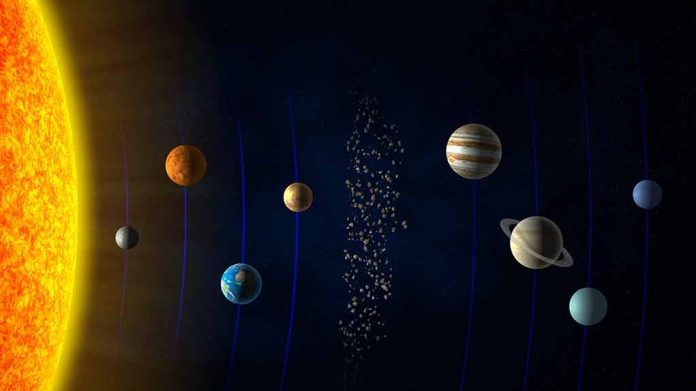
When we think of astrology, most of us picture the classic lineup: Sun and Moon signs, and the movements of the planets like Mercury, Venus, and Mars. But in recent decades, modern astrologers have expanded their celestial toolkit to include a host of smaller yet deeply meaningful bodies: the asteroids. Specifically, a number of these lie in the asteroid belt between Mars and Jupiter, and they’ve become valuable additions in understanding personality, life purpose, and relationships on a more nuanced level.
What Asteroids Are Used in Astrology?
The region between Mars and Jupiter is home to thousands of rocky bodies, remnants from the early solar system. This area, known as the main asteroid belt, is filled with objects of all sizes, but a few have become particularly prominent in astrology. The four most commonly used are Ceres, Pallas Athene, Juno, and Vesta. Each is named after a Roman or Greek goddess and each brings unique archetypes into a birth chart.
These celestial bodies might be small in size compared to planets, but in astrology, significance isn’t based on physical mass alone. Asteroids add layers of complexity and texture to chart readings, giving voice to parts of the psyche that might otherwise be overlooked.
Ceres: The Nurturer
Ceres is the largest asteroid in the belt and was the first to be discovered (in 1801). She represents nurturing, care, food, and the cycles of loss and return. In mythology, Ceres (or Demeter in Greek mythology) was the mother of Persephone and the goddess of agriculture. Her grief at losing her daughter to the underworld gave rise to the changing seasons.
In a natal chart, the placement of Ceres can speak to how you give and receive care, your relationship to food and physical nourishment, and even your ability to grieve and find renewal. For someone whose Ceres is strongly placed, caregiving may be a central theme in their life, whether that’s expressed through parenting, healing professions, or activism.
Pallas Athene: The Strategist
Pallas Athene is associated with wisdom, strategy, and creative intelligence. She’s the daughter of Zeus, born fully armored from his head, symbolizing thought that emerges from clarity and vision. Pallas is not about brute force, but about solving problems with diplomacy, insight, and inventiveness.
Astrologically, Pallas shows where and how you apply strategic thinking, especially when it comes to problem-solving, artistic expression, and advocacy. It also connects with the mind-body connection. Pallas is often active in charts of dancers, designers, and those who express intelligence through form and movement.
Juno: The Partner
Named after the queen of the gods, Juno speaks to partnership, commitment, and the sacred contract of marriage. Juno’s myth is complex. She’s powerful, but her story includes themes of betrayal, loyalty, and resilience within intimate relationships.
In astrology, Juno helps reveal what you need in a long-term partnership and what kind of person you are likely to attract (or be attracted to). It also can shine a light on patterns of jealousy, fidelity, and equality within close relationships. If Venus shows how we love, Juno shows how we commit.
Vesta: The Sacred Flame
Vesta is the asteroid of devotion, purity, and inner focus. In ancient Rome, the Vestal Virgins were priestesses who tended the sacred flame, a symbol of spiritual integrity and service. Vesta in a chart often represents where you are most devoted, where you can focus deeply, and sometimes where you might sacrifice personal needs for a higher calling.
It can also point to areas of bodily autonomy, spiritual commitment, or periods of celibacy and self-reflection. Vesta invites us to find the sacred in the everyday and to honor the fire within.
Why Use Asteroids?
You might be wondering: if the traditional planets already tell us so much, why add more? The answer lies in depth and specificity. Asteroids are especially helpful when you’re exploring themes related to gender roles, identity, and personal empowerment. Because these asteroids are named after goddesses, they often highlight feminine archetypes that aren’t fully represented by the traditional planetary lineup.
For example, someone might have a strong Mars indicating assertiveness and drive, but a prominent Pallas could show that their approach is more intellectual or diplomatic than forceful. Juno might explain why certain types of relationships feel more sacred or binding than others, even if the Venus aspects don’t suggest it.
How to Find Them
Most modern astrology software and chart calculators (we love astro.com) allow you to include these asteroids in your chart. Once you see where they fall — by sign, house, and aspect — you can start exploring how these subtle forces are at play in your life. And while they’re not always the stars of the show, they often illuminate background themes that can bring a reading to life.
Incorporating asteroids into your astrological practice doesn’t require you to throw out what you already know. They simply add color and context. Like supporting characters in a novel, they may not carry the entire plot, but they often deliver the most memorable, insightful moments.











